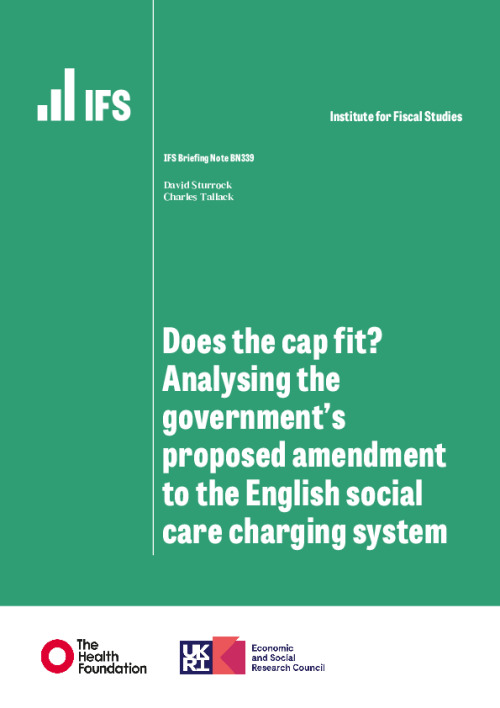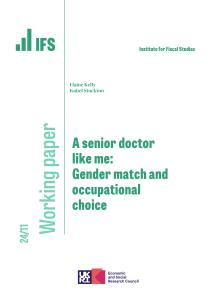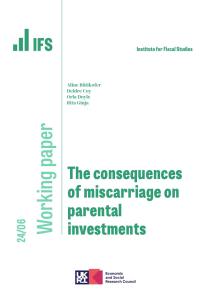In September 2021, the government announced that a cap on lifetime social care costs would be operationalised in England from October 2023, set at a level of £86,000. When the possibility of a cap was first legislated for in the 2014 Care Act, that legislation set out that total personal care costs incurred (including those covered by means-tested council funding for those with low assets or income) would count towards the cap. However, in November 2021, the government proposed to amend the Care Act so that an individual will reach the social care cost cap when the amount they have spent themselves (excluding any means-tested support from their council) reaches £86,000. The government estimates that this amendment will save £900 million per year from 2027–28, reducing the cost of the social care cap by around a fifth.
This briefing note considers the effects of the government’s proposed amendment to the Care Act, which would mean that means-tested support does not count for an individual’s progress towards the social care cost cap. Our analysis does not compare the government’s proposed system with the existing system (which does not include a cap). Rather, we compare the government’s proposed system with how the new system (including the cap) would work without the proposed amendment to the Care Act.
We present analysis of which groups of older people would be affected by the proposed amendment, looking at differences between those with different levels of wealth and income and those living in different parts of England. To do this, we use information on the assets and income levels of different groups of older people and calculate the proportion of assets that they would be required to contribute towards their care costs under a number of different care journeys, both with and without the government’s proposed amendment to the Care Act.
Key findings
How the effects of the amendment would depend on income, wealth and care recieved
- The majority of care journeys are unlikely to be affected by the government’s proposed amendment to the cap because most people would not reach the care cost cap or would not receive means-tested support, even under the cap as currently legislated. However, the proposed amendment to how the cap will work would significantly reduce the protection against large costs – one of the main motivations for introducing the cap – for those who might draw on means-tested support, relative to plans set out in existing legislation. Given the unpredictability of future care need, this would reduce the benefits of the cap in terms of helping people plan and have peace of mind around future care costs.
- The government’s proposed amendment would mean that those with moderate income or assets, and who receive means-tested support to help them with care costs, would take longer to reach the cap, or never reach it. Without the government’s amendment, someone needing residential care costing £700 per week would reach the cap after 3 years and 4 months, regardless of their levels of income and assets. With the amendment, someone with that care need who has annual income of £16,000 and assets of £100,000 would take almost 6½ years to reach the cap.
- As a result, those experiencing costly care journeys, and who would be eligible for means-tested support, would make contributions for longer, and spend more on their care, under the government’s plans, compared with how the cap is currently legislated for. Under a ‘worst case’ cost scenario of a decade spent in residential care, someone with £106,000 in assets and annual income of £11,800 would be most affected. Under the government’s plans, their contribution towards their care would be £76,000, or 71% of their initial assets, compared with £44,000, or 41% of their assets, under existing legislation (a rise of £32,000, or 30% of their assets). In this scenario, those with assets of over £186,000 would be unaffected.
- Those who spend an extended period requiring domiciliary care and subsequently enter residential care would face particularly large impacts of the proposed amendment to the cap. Under a scenario of 5 years receiving domiciliary care and then 5 years in residential care, someone with annual income of £12,000, housing wealth of £75,000 and other assets of £25,000 would see their assets depleted by £52,000 under the government’s proposed amendment, compared with £12,000 under current legislation, an increase of £40,000, or 40% of their initial assets.
- Those with large amounts of total wealth, but less than £186,000 of non-housing wealth, can be affected by the proposed amendment to the cap. This is because they could be eligible for mean-tested support if receiving domiciliary care and this support would not count towards the cap under the government’s plans. Under a scenario of 2½ years spent in receipt of domiciliary care and then 2½ years in residential care, someone with annual income of £12,000 and wealth of £250,000 (with three-quarters in the form of housing wealth) would see their assets depleted by an additional 5% (£12,500) under the government’s plans.
- Working-age adults with modest income and significant care costs could be significantly affected by the government’s proposed reform. They would be required to use any income they have above the minimum income guarantee (£91.40 for someone aged between 25 and pension credit age) to pay for their care until they hit the cap. Their income could be limited to this level for years longer as a result of the government’s proposed amendment.
How the amendment would affect protection against high care costs for different groups of older people
- Under the government’s plans, those in the second wealth quintile of those aged 65 and older (wealth per person of between £83,000 and £183,000) would face the biggest loss of protection against high care costs, relative to the system under existing legislation. The government’s plans would mean that a 10-year residential care journey would consume an additional 10% of assets or around £12,000, on average, for those in the second quintile. This compares with 1%, or £2,300, for the fourth quintile and a negligible effect for the top quintile. A care journey consisting of 5 years of domiciliary care followed by 5 years of residential care would deplete an additional 21% of assets, or £27,500, for those in the second quintile, on average.
- Levels of wealth vary substantially across England and this would feed through to different impacts of the proposed amendment across regions. Average wealth among the population aged 65 and over in the North East is around £150,000, compared with an average of around £490,000 in London.
- Those in the North East, Yorkshire and the Humber, and the Midlands would see the biggest erosion of their protection against large care costs, as a result of the proposed amendment. If they were to spend 10 years in residential care, one in four individuals in the North East would have to contribute an additional 10% of their initial assets to cover their care costs, as a result of the amendment. This compares with just one in forty of those in London. If they were to spend 5 years in receipt of domiciliary care followed by 5 years in residential care, the government’s plans would mean those in the North East would have to contribute an additional 12% of their assets towards their care costs, on average, compared with an additional 5% for those in London.
- For shorter care journeys, those in parts of the country where care costs are higher are more likely to be affected by the proposed amendment. Those in high-cost areas such as the South and East of England would hit the cap faster under the unamended system than those in lower-cost areas such as the North West and Midlands. Under a care journey of 2½ years receiving domiciliary care and then 2½ years in residential care, we estimate that those in the North West would not hit the cost cap with or without the proposed amendment, and so are unaffected. By contrast, those in the South East would have to contribute an additional 3% of their assets to their care if the proposed amendment to the cap is implemented.
- The government’s proposed amendment would not substantially increase the number of people at risk of having to use their housing wealth to pay for a long period of residential care, other than in the case where they first spent significant time receiving care at home. This is because most individuals who would receive means-tested support and have some housing wealth would have to draw on it even under the system without the amendment.











